




The Berkeley-Charleston-Dorchester (BCD) Region*, named for the three counties that make up the area, represents a diverse mix of communities, cities, towns and varied economies that all contribute to the continued rapid growth of the area. According to the Charleston Regional Development Alliance (CRDA) an estimated 30+ new residents move to the Region every day.1
The BCD Comprehensive Economic Development Strategy (CEDS) will guide effective economic development in the region through “a locally-based, regionally-driven economic development planning process.” The idea of the CEDS was created by the Economic Development Agency (EDA) in order to “successfully serve as a means to engage community leaders, leverage the involvement of the private sector and establish a strategic blueprint for regional collaboration.”2 With a focus on establishing a “strategydriven plan” to aid in the prosperity of the region, the CEDS also promotes economic resiliency, which will aid in addressing future downturns and natural disasters.
Berkeley-Charleston-Dorchester Council of Governments (BCDCOG)
The BCDCOG is the regional government that facilitates coordination, cooperation and implementation across multiple jurisdictions in the tri-county area. Local governments in Berkeley and Charleston Counties first created a Regional Planning Commission in 1968 to encourage a regional approach to issues. Dorchester County government elected to join the Commission three years later. In 1976, the organization changed its name to the Berkeley-Charleston-Dorchester Council of Governments. Governed by a board of 57 members, consisting of a mix of elected and appointed members from each of the counties and municipalities within the region, these leaders work together to make decisions which aid in guiding the future of the area.
Specific examples of BCDCOG services range from current planning for small towns to implementation of the future Lowcountry Rapid Transit (LCRT) line. LCRT is designed as a 21.3-mile modern bus rapid transit system that will connect communities in our region like never before. Operating mostly in dedicated lanes, LCRT will provide safe, reliable and low-cost connections between Ladson, North Charleston and Downtown Charleston.
The BCDCOG provides various services to the Region, these include:
• Regional Planning
• Transportation Planning
• Workforce Development
• Economic Development
• Community Development
• Comprehensive Planning
• Regional Water Quality Management
The BCD CEDS Steering Committee was made up of representatives from the economic development departments of Berkeley, Charleston and Dorchester counties, Goose Greek, Summerville, City of Charleston, North Charleston and Mount Pleasant. These professionals served on the committee to ensure that our regional approach to economic development planning effectively addresses challenges, builds resiliency and takes advantages of opportunities across the region.
There are several resources and plans which aim to guide the region from not only an economic standpoint, but also from a resilience and workforce development perspective.
• One Region Roadmap (BCDCOG, CRDA, Charleston Metro Chamber)
• Economic Cluster & Innovation Strategy (CRDA)
• 2022 Talent Demand Study (Charleston Metro Chamber, CRDA)
• Comprehensive Plans for Berkeley, Charleston and Dorchester counties
• Economic Development Strategic Plans for Berkeley, Charleston and Dorchester counties
• TWDB Workforce Innovation and Opportunity Act Regional Plan
• 2025 Charleston Inspired Strategic Plan (CRDA)
* – Throughout the CEDS the term “region” encompasses all of Berkeley, Charleston and Dorchester counties.
1 - Source: CRDA. 2022. “Population and Demographics.” www.crda.org/local-data/population-demographics
2 - Source: Economic Development Agency. 2022. “CEDS Content Guidelines: Overview.” www.eda.gov/ceds
813,052
The region has a strong sense of place. One that is steeped in history and abundant natural beauty. It is also one where the population and the economy has grown rapidly in recent years. Retaining the region’s quality of place by growing sustainably, while creating opportunities for all residents in education, jobs and housing will be instrumental in ensuring success for years to come.
Growth across the region far outpaced the U.S. Berkeley County led the way, growing 343% faster than the U.S. This is due to the large tracts of less expensive and available land to develop and the lower housing prices found further from Charleston’s city center.
The region is growing significantly faster than the U.S. in many metrics including: population, employment, housing prices and GDP growth. This has affected everything from affordability and talent retention to infrastructure capacity. The data that follows shows the successes, the challenges and resiliency of the region.

The region has a young population with the largest sector being 25 to 44 years of age. This is a competitive advantage for business and talent recruitment, retainment and development.
Source: U.S. Census Bureau, 2021 American Community Survey, 1-Year Estimates
The region’s strength lies in its people, representing a wide range of backgrounds and experiences. The One Region Roadmap emphasizes the importance of expanding access to high-quality education, jobs, and housing so that all residents can share in the region’s continued growth.
Source: U.S. Census Bureau, 2021 American Community Survey, 1-Year Estimates
21.6% of the population 5 and over speak another language than English at home in the U.S. This percentage is almost three times larger than found in the region. The region’s percentage has decreased from 7.6% since 2011.
Source: U.S. Census Bureau, 2021 American Community Survey, 1-Year Estimates
There is a direct connection between educational attainment and earnings achieved. Many of the jobs within the economic clusters in the region require more than a high school diploma. To ensure everyone has an opportunity to take part in the region’s economic success, it’s important residents understand this link between education, earnings and current and future job opportunities.

The information industry has the largest average salary in the region at $105,725, yet it’s 44.3% less than the U.S. average. Leisure and Hospitality is the fourthlargest industry in employment size in the region and offers the lowest average salary. The region must work to grow salaries across all industries to remain competitive in recruiting and retaining talent. With housing costs growing rapidly (see page 9), combined with a lower average salary, affordability is an urgent challenge the region must address.
Since 2011, employment in the region has grown over twice as fast as the U.S. It was also more resilient in 2020 with the initial onset of COVID-19 and recovered faster from both the Great Recession and COVID-19.
Source: Charleston Regional Data Center
Source: Charleston Regional Data Center
The growing population has caused housing prices to rise rapidly in the region. This trend increased in the months that followed the onset of COVID-19. People from around the country began to move away from larger cities to more affordable, smaller metros with more square footage, yards and greenspace availability. In addition, housing construction has not kept up with demand, forcing prices higher.
The poverty rate in the region is 11.7%, slightly lower than the U.S. at 12.8%. Poverty affects females, minorities and those under 18 at the highest percentage rates. Economic prosperity must be shared by all residents to alleviate poverty.
— U.S. — BCD Region
Source: Charleston Trident Association of REALTORS, 2021 Annual Report on the Charleston Area Housing Market
A number of major firsts occurred over the last decade in the region driving GDP growth at a faster rate than the U.S. In 2012, Boeing delivered the first 787 Dreamliner assembled in S.C., in 2019 Volvo began exporting their first cars and SC Ports grew annual TEU volume by 102% from 2010 to 2021.
The total number of firms in the region grew 20.9% from 2010 to 2020 with the majority of that growth happening in firms employing under 500 employees. Only 8% of firms employed 500 or more in 2020. This shows the importance of small businesses in driving GDP growth.
Source: U.S. Census Bureau, Business Dynamic Statistics
Source: Bureau
In 2020, COVID-19 stressed the global supply chain and caused the first year-overyear decrease in TEU volume since 2009. Following the recession it took five years for TEU volume to exceed prerecession volume. It only took one year for TEU volume to exceed pre-COVID-19 levels, growing 19.1% from 2020 and exceeding 2019 by 13%.

The region is located in the central area of the South Carolina Lowcountry. The tricounty area, made of Berkeley, Charleston and Dorchester Counties, has a land area of 2,614 square miles and 91 miles of coastline along the Atlantic Ocean.
Major highways and interstates run throughout the Region, these include: I-26, I-95, I-526, U.S. 17, U.S. 52 and U.S. 78. These corridors provide easy access to all areas west of the region, including the densely populated Middle Atlantic states.
Nationally, the region is essentially the midpoint between Miami and New York City. Locally, the region acts as the recreational center among prominent points in the state such as Columbia and Myrtle Beach and is also only a two-hour drive from its Colonial counterpart, Savannah. According to the CRDA, more than one-fifth of the U.S. population resides within 500 miles of the region.
The area has a long and complex history, much of which has been preserved for future generations to see, experience and learn from. One can visit an array of parks and historical sites from Charles Towne Landing State Park where European’s established their first permanent settlement in South Carolina1, to Fort Sumter National Monument where the Civil War began, to the Old Slave Mart Museum2 which housed Charleston’s last major slave market. The International African American Museum is scheduled to open in January of 2023, further enhancing the understanding the history and impact of the Africans experience in South Carolina, the U.S. and throughout African Diaspora.3
1 – Source: Charles Towne Landing State Park. 2022. southcarolinaparks.com/charles-towne-landing/ history-and-interpretation
2 – Source: Old Slave Mart Museum. 2022. www.oldslavemartmuseum.com
3 – Source: International African American Museum. 2022 . www.iaamuseum.org

SC Works Trident, a BCDCOG workforce development program, offers services through its three centers located in North Charleston, Moncks Corner and Summerville as well as a mobile job center, the SC Career Coach. SC Works Trident connects businesses, job seekers, and training providers to create a pathway to employment in the region’s leading industries.5
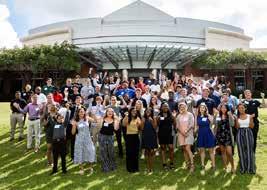
Another resource for the workforce development agency is readySC. A division of the SC Technical College System, readySC exists to promote the economic and workforce development of the state of South Carolina by providing customized recruiting and training solutions for new and expanding businesses at little to no cost to qualifying companies. The main industries readySC serves are aerospace, automotive, biotech, call centers, chemicals, distribution, food and food processing, metal, plastics, textiles and various others.6
The area has been a leader in recognizing the value of protecting its historical assets. The Preservation Society of Charleston was established in 1920 as the nation’s first preservation organization.4 Various preservation organizations in the area aid in preserving these symbols of culture and history. Some of these organizations include: Historic Charleston Foundation, Berkeley County Historical Society, Dorchester County Historical Society and the Upper Dorchester County Historical Society.
In addition to historic preservation, the Region also offers various other cultural exposures such as the Spoleto Arts Festival, Piccolo Spoleto Festival, MOJA Festival, Latin American Festival, the Flowertown Festival, The Gibbes Museum of Art, South Carolina Aquarium and sports teams including, the Charleston RiverDogs (baseball), South Carolina Stingrays (hockey) and Charleston Battery (soccer).
4 – Source: Preservation Society of Charleston. 2022. www.preservationsociety.org/about
5 – Source: SC Works Trident. 2022. www.scworkstrident.org/about
6 – Source: readySC.2022. www.readysc.org
7 – Source: Charleston Metro Chamber of Commerce. 2022. www.charlestonchamber.org/career
The Charleston County School District operates three Centers for Advanced Studies, where curriculum focuses on high-tech, high-wage, in-demand jobs of regional business and industry. The Dorchester County Career and Technology Center is another example of local school districts aligning their curriculum with the needs of the business community. Centers such as these simultaneously increase the employability of students while addressing the workforce needs of regional employers.
The Charleston Metro Chamber of Commerce has also taken on the effort to increase the region’s workforce development capacity. The Chamber has partnered with regional education and business partners to increase the area’s talent pipeline through a series of initiatives. These initiatives include:
• Career Academies: Located within high schools across the tri-county area, these programs seek to engage students in high-demand work sectors through internships and immersive career driven classes.
• Youth Apprenticeship Programs: Programs that connect high school juniors and seniors with local companies, who hire them as apprentices while in school.
• TEALS: Microsoft nonprofit, TEALS, Technology Education and Literacy in schools partners with local high schools to increase offerings of computer science classes.7

CARTA’s Board of Directors recently voted to approve a Battery Electric Bus Master Plan & Roadmap that will guide the Authority’s efforts to transition to a 100 percent battery-electric bus fleet for its fixedroute service.9 (Photo/CARTA)
The primary mode of transportation in the region is the automobile or single occupant vehicle (SOV). However, since COVID-19 the percentage of commuters in a SOV dropped to 72.2% in the region in 2021, from 81.1% in 2019. Concurrently, the percentage of people who worked from home increased from 6.7% in 2019 to 16.1% in 2021.
The majority of the region commutes to Charleston County for employment. According to Census Bureau data, 88.9% of Charleston County residents work in their resident county. Comparatively, only 52.1% of residents in Berkeley County and 48.2% in Dorchester County worked in their resident county.8
The region is positioned where two major federal interstates (I-26 and I-95) intersect. I-526 provides a bypass for U.S.-17 and various U.S. highways (U.S.-17, U.S.-52, U.S.-78) cut through the area. Given the low density of the region and unbalanced investment on roadways versus transit, diverse transportation options are currently limited for residents.
BCDCOG administers the two primary public transportation systems in the region, Charleston Area Regional Transportation Authority (CARTA) and TriCounty Link (TCL).
CARTA covers the urbanized area of the region and is the state’s largest public transportation provider with a ridership of well over four million annually.
TCL serves the rural areas of the region with nine regular fixed routes and six commuter routes. Although the bus service maintains their published schedules, each route offers a “route deviation option,” which means the driver may go up to a quarter mile off the fixed route to pick up customers that are unable to get to designated bus stations. This is also a flag-stop system and will pick up customers between scheduled stops.10
The Charleston International Airport (CHS) and the Airforce base are colocated on the runways of Joint Base Charleston in North Charleston. CHS offers non-stop flights to 43 markets across the U.S. Due to demand, the airport has been under constant expansion. In September 2022, an $11.5 million expansion was completed for an additional three gates to Concourse A, increasing gate capacity by 20%.11
In 2019, the $14.5 million North Charleston Transit Center opened as a transportation hub for Amtrak, CARTA and regional bus service from Southern Stages. In addition, it includes community meeting space and a historic display room dedicated to the Liberty Hill Community, the oldest free black community in S.C.12
Aside from passenger-related transportation, the Port of Charleston moves large amounts of freight throughout the region and beyond through federal interstates and U.S. highways (I-26, I-95, etc.) and railroad corridors (Palmetto Railways, CSX, NorfolkSouthern). The RapidRail dray program provides cost-effective connection between the marine terminals and rail yards. Also, the Inland Ports in Greer and Dillon connect the I-85 and I-95 corridors to the Port of Charleston via rail. Utilizing and expanding the rail infrastructure helps to keep freight off the region’s already congested roads.13
8 – Source: U.S. Census Bureau. 2021. “American Community Survey, 1-Year Estimates.” data.census. gov
9 – Source: BCDCOG. 2022. “Carta Board Approves Electric Bus Master Plan & Road Map.” www. bcdcog.com/carta-board-approves-electric-bus-master-plan-road-map/
10 – Source: BCDCOG. 2022. “Transportation Administration.” www.bcdcog.com/ transportation/ administration/
11 – Source: Charleston International Airport. 2022. “ CHS Expands Gate Capacity.” www.iflychs.com/ chs-expands-gate-capacity-f0d4dca654e6b012
12 – Source: Charleston Regional Business Journal. Sept. 4, 2019. “New intermodal facility opens in North Charleston.”www.charlestonbusiness.com/news/transportation/77027
13 – Source: SC Ports. 2022. “Rail Connections.” www.scspa.com/cargo/logistics/rail-connections

The region lies at the edge of the Coastal Plain, which comprises the southern and eastern third of the state and consists of slightly rolling terrain near the midlands and flat terrain toward the coast. Its elevation varies from sea level to about 300 feet across all three counties. The region’s coastline makes up approximately 50 percent of the 187-mile-long general coastline of South Carolina (not including off shore inlands, sounds bays, rivers, creeks, etc.). Protecting the region’s coastline are many barrier or sea islands. These major islands in the region include Dewees Island, Edisto Island, Folly Beach, Isle of Palms, James Island, Johns Island, Kiawah Island, Seabrook Island, Sullivan’s Island and Wadmalaw Island. Also covering the coast and parts of the inland are tidal and freshwater marshes, which extend south into Georgia.
Regional wetlands, both coastal and inland, greatly affect development patterns, as well as expansion of infrastructure. Both the Cooper River and Wando River watersheds lie within the Santee River Basin in the Coastal Plain region of South Carolina. The Wando River originates from the I’on Swamp and wetlands within the Francis Marion National Forest in Charleston County, and flows generally southwestward until the confluence with the Cooper River, upstream of the Charleston Harbor. The Cooper River is formed at the confluence of the East Branch Cooper River and West Branch Cooper River, and then flows southward towards the Harbor. Both watersheds have high potential for population growth and residential, commercial and industrial development. Development in this area is challenging due its three-sided, low-lying characteristics. Watershed areas should also be integral in flood mitigation planning.
14 - Source: WCSC. 2022. March 19, 2022. “Summerville’s new park is now open to every age and ability.” www.live5news.com/2022/03/19/summervilles-new-park-is-now-open-every-age-ability/
The region has one of the most abundant ecosystems in South Carolina with innumerable natural resources. Located throughout the three counties, residents have access to seven beaches, which include: Folly Beach, Isle of Palms, Edisto Beach, Kiawah Island, Seabrook Island and Sullivan’s Island. Additional natural resources include:
• ACE Basin National Wildlife Refuge
• Various tidal rivers and creeks: Ashley River, Cooper River, Wando River, Edisto River, Stono River, Wappoo Creek and many others
• Francis Marion National Forest, Audobon Society’s Beidler Forest and the Cape Romain Wildlife Refuge
Municipalities and counties own and manage hundreds of parks covering thousands of acres across the region. The park systems continue to expand to protect undeveloped land. In 2022, Dorchester County opened the 85-acre Ashley River Park, and has already purchased an additional 120-acres to expand the park.14 Efforts such as these conserve the land and give the public the opportunity to enjoy these natural assets.
There are also two Santee Cooper-built lakes, Lake Marion and Lake Moultrie, which provide a variety of recreational activities and tourism in the upper area of Berkeley County. There are several conservation groups that work throughout the region to protect the area’s natural resources including: Coastal Conservation League, Lowcountry Land Trust and the Coastal Conservation Association (CCA), South Carolina Chapter.
Traded Clusters
The region is fueled by a diverse economic base ranging from world-class hospitality to state-of-theart aeronautical and automotive manufacturing. Each county brings a variety of industries to the table creating a strong, cohesive economic foundation for the region. The CEDS steering committee focused on six-clusters based on the CRDA Economic Cluster & Innovation Strategy: Aerospace, Automotive, Information Technology, Life Sciences, Logistics and Tourism. They also identified emerging sectors: renewable energy, e-mobility and small-scaled manufacturing.
The Charleston region has a diverse economy. Economic clusters can be further grouped into five major categories: Knowledge Creation, Business or Professional Services, Manufacturing, Tourism and Entertainment, and Logistics. Clusters are often initially evaluated by two simple performance metrics: job change and location quotient, the latter of which denotes a competitive advantage relative to the nation. Multiple clusters within the Charleston region reported job change exceeding 100% from 2010 to 2021, including Performing Arts, Information Technology, Aerospace Vehicles and Defense, and Automotive.
Some clusters with relatively high reported job change, including Information Technology, Performing Arts, and Life Sciences, continue to report a location quotient near 1.0. Location quotients in excess of 1.0 indicate there is a greater concentration of jobs within the region than the concentration of that industry nationwide. Nearly all manufacturing clusters within the region have location quotients over 2.0, meaning the region has twice the concentration of jobs than the nation does overall. Clusters with both a high reported job change and high location quotient are strong candidates for designation as a priority cluster.
CLUSTER CATEGORIES
TRANSITIONING: Clusters that are downsizing. Jobs are declining and there is a low location quotient*
MATURE: Strong and stable clusters. There is a high location quotient but limited job growth.
The below graphic shows economic growth evaluated through Traded Clusters. ‘Traded clusters’ are defined as groups of related industries that serve markets beyond the region in which they are located. All of the economic clusters the region is currently focused on are either in the star, or emerging quadrants, indicating their current strength and potential for continued growth.
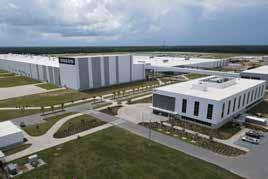
Sources: EMSI, SB Friedman
Note: Hospitality includes local and traded clusters
The Volvo plant in Berkeley County opened in 2018 and has expandedalready to produce the Polestar 3 electric vehicle. (Photo/ Volvo Car USA)
Sources: One Region Roadmap: Economic & Resiliency Plan; CRDA Economic Clusters & Innovation Strategy
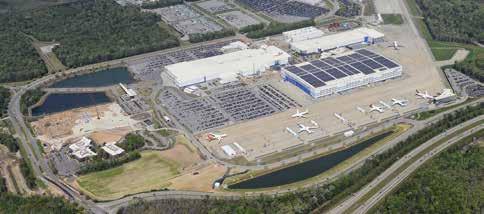
The region boast’s one of the fastest-growing aerospace clusters in the country. The rapid expansion began with the arrival of Boeing in 2009. Today, the Boeing Campus in North Charleston is the only location in the world for the final assembly and delivery of the 787 Dreamliner.
Many aerospace suppliers also are operating in the region including: TIGHITGO, General Electric and Parker Aerospace. In addition, Trident Technical College opened the S.C. Aeronautical Training Center to develop the talent needed to fuel further growth in the aerospace cluster.

The region has seen significant growth in the automotive sector with the arrival of Volvo and the $500M expansion of Mercedes-Benz Vans both announced in 2015. Volvo now produces the S60 sedan and XC90 SUV from its plant in Berkeley County and will soon produce the new, all-electric, Polestar 3 SUV.1 Mercedez-Benz Vans has assembled more than 260,000 Sprinter and Metris Vans in North Charleston.2
Over 65 automotive original equipment manufacturers (OEMs), parts manufacturers, distributors and other suppliers operate in the BCD Region including: Bosch, Turbo Technologies and Stoba.
The Port of Charleston allows automobile manufacturers to easily reach the global marketplace.
1 – Source: CRDA Economic Clusters & Innovation Strategy. 2022.
1 – Source: Volvo Cars. 2021. “Volvo Cars Expands U.S. Electrified Vehicle Production in South Carolina with New $118 Million Investment.” www.media.volvocars.com/us/en-us/media/pressreleases/283096/ volvo-cars-expands-us-electrified-vehicle-production-in-south-carolina-with-new-118-million-investme
2 – Source: Mercedes-Benz Vans. 2022. www.mbvcharleston.com
3 – Source: CRDA Economic Clusters & Innovation Strategy. 2022.
Viktor Scientific is one of the Life Sciences companies located in the WestEdge development. (Photo/ WestEdge Foundation)

According to the CRDA, the region ranked as the #3 mid-sized metro for pharmaceutical and medicine manufacturing job-growth. More than 300 medical device and pharmaceutical manufacturers, research laboratories and service companies operate in the region including: Thorne Research, Charles River Laboratories and Hillrom. With the Medical University of South Carolina (MUSC) funding over $284M for research annually, and the creation of the MUSC Discovery District at WestEdge, the stage is set for further growth in this highimpact cluster.1

The information technology (IT) sector features a diverse group of businesses from startups that have gone on to launch IPOs like Blackbaud and Benefitfocus, to tech giants like Google, to hundreds of innovative startups. Niche sectors in the region include: cybersecurity, defense IT, health IT, human resources IT and software products. According to the CRDA, the Charleston Metro is a Top 20 U.S. Metro for High Tech GDP growth from 2014 to 2021.1
In 2021, the Charleston Digital Corridor (CDC) opened the 92,000 sq. ft. Charleston Tech Center in downtown Charleston to serve the needs of tech startups, the building is almost 100% filled.2
4,300
1 – Source: CRDA. 2022. www.crda.org/life-sciences
2 – Source: CRDA Economic Clusters & Innovation Strategy. 2022.
1 – Source: CRDA. 2021. “Information Technology.” www.crda.org/assets/pdf/target-industries/Charleston_SC_Economic_Profile_Info_Tech_2021.pdf
2 – Source: Charleston Digital Corridor. 2022. “Flagship @the Charleston Tech Center” www.charlestondigitalcorridor.com/spaces/flagship-charleston-tech-center
3 – Source: CRDA Economic Clusters & Innovation Strategy. 2022.
1
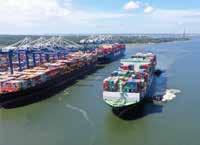
Charleston’s existence as a trade port has been maintained since its founding in 1670. Recently, SC Ports has invested more than $2 billion in port infrastructure to accommodate the rapid growth and arrival of post-panamax cargo ships. Phase one of the Hugh K. Leatherman Terminal was opened in March 2021. This was the first greenfield container terminal to open in the U.S. since 2009. In addition, the Charleston Harbor Deepening Project will be completed in 2022 making Charleston the deepest harbor on the east coast at a depth of 52-feet.1
Having a world-class port has made the region a logistics hub. CSX and Norfolk Southern both operate intermodal rail yards. SC Ports also operates, Inland Port Greer and Inland Port Dillon making it easier to reach the Port of Charleston by rail.2 I-26 is the major interstate in the region and connects directly to I-95, I-77, I-20, I-85 and I-40 making it possible to easily reach the rest of the country.3
The industrial real estate market is surging due to the continued growth of the logistics sector. As of Q2, 2022, the overall market inventory for manufacturing, industrial and warehouse space was at 60.1 million square feet with a vacancy rate at 0.6% with 8.8 million square feet under construction, to try and meet the high demand.4
BY THE NUMBERS
$63.4 billion
Economic Impact of SC Ports in S.C.5
52 feet
Depth of Charleston Harbor following the deepening project6
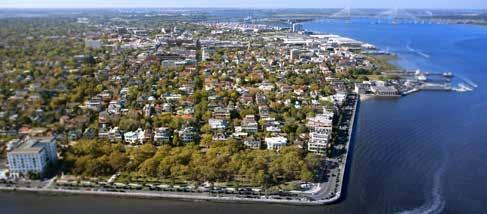
One of the most established economic drivers in the region is the tourism sector. The region boasts a wealth of historical, cultural and natural resources and a worldrenowned food scene. The College of Charleston Office of Tourism Analysis found that tourism had a $10.62 billion economic impact in 2021. That was up $4.5 billion from 2020 when the tourism sector was hit hard by the emergence of COVID-19. 2021 outperformed 2019 by $1 billion showing how strong this sector has roared back.1 In 2022, Travel + Leisure named Charleston the number 1 city in U.S. for the tenth year in a row, validating the region’s tourism success.2
$10.62 billion
$1.5 billion
Capital investments announced by TDL firms in S.C. from 2017-20217
– Source: SC Ports. 2022. “Port Expansion.” www.scspa.com/facilities/port-expansion/
2
– Source: SC Ports. 2022. “Rail Connections.” www.scspa.com/cargo/logistics/rail-connections/
3
– Source: SC Ports. 2022. “Highway Connections.” www.scspa.com/cargo/logistics/highway-connections/
4
– Source: Bridge Commercial. Q2, 2022. “Industrial Market Report.” www.bridge-commercial.com/quarterlyreports/q2-2022-industrial-tdrpf-fykyy
5,6
7
– Source: SC Ports. 2022. “Port Expansion.” scspa.com/facilities/port-expansion/
– Source: S.C. Department of Commerce. 2022. “Distribution & Logistics Industry.” www.sccommerce.com/industries/distribution-logistics-industry
2
1
Economic impact of tourism in the BCD Region
53,046
Total employment in Leisure and Hospitality in the BCD Region in Aug. 2022. That is up from 25,093 employees in April 2020 during COVID-19’s initial impact. It also surpasses pre-COVID-19 employment in Feb. 2020 which stood at 51,537 employees.3
– Source: College of Charleston Office of Tourism Analysis. 2022. “2021-2022 Annual report” sb.cofc.edu/centers/ tourismanalysis/annualreports/otaannualreport20212022.pdf
– Source: The Post and Courier. June 12, 2022. “Charleston named No. 1 city in US for 10th straight year by Travel + Leisure magazine” www.postandcourier.com/business/tourism/charleston-named-no-1-city-in-us-for-10thstraight-year-by-travel-leisure-magazine/article_26fc296c-01f2-11ed-a81f-23e1c36f301d.html
3 – Source: Federal Reserve Economic Data. Aug. 2022“All Employees: Leisure and Hospitality in Charleston-North Charleston, SC (MSA)” fred.stlouisfed.org/series/CHAR745LEIH
With the Clemson University Dominion Energy Innovation Center, the world’s most-advanced windturbine drivetrain testing facility, and the recent opening of Nexans who manufacture high voltage subsea cables to bring electricity produced offshore to land, the region is poised to be a major player in wind energy. With a federal target of creating 30 gigawatts of offshore wind power by 20301, momentum is gaining to use wind to power the region’s homes and employ its residents.
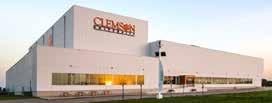
Small-scale manufacturing has become more prevalent due partly to the ability to sell goods online and low-cost tools enabling production runs to be small and on-demand. Products include everything from food and beverage production to artisan’s handmade goods.
One of the most visible examples of small-scale manufacturing in the region is the robust beverage industry, anchored by craft breweries and distilleries. Many are located within neighborhoods and have become gathering places that boost revitalization efforts, foot-traffic, commerce and community pride.
Another example of renewable energy in action is The Dorchester Project, a 20 MW biomass fired facility in Dorchester County, fueled by mill and harvesting residues.2 Also, the installation of a Community Solar Garden by Berkeley Electric Cooperative that allows members to lease solar panels, located in the garden, and be credited with the output, rather than installing panels on their roof.3
1 – Source: U.S. Department of the Interior. 2022. “Clean Energy Future.” www.doi.gov/priorities/clean-energy-future
2 – Source: Atlantic Power & Utilities. 2022. www.atlanticpower.com/assets/projects/dorchester
3 – Source: Berkeley Electric Cooperative. 2020. “Community Solar.” www.berkeleyelectric.coop/community-solar
With strong automotive and logistics sectors already in place, the region has the foundation to become a leader in e-mobility. Investments will be needed to develop a skilled workforce, expand charging infrastructure capable of supporting hurricane evacuations and accelerate the electrification of the logistics industry. These efforts will position the region as a hub for nextgeneration transportation innovation.
Another example is, Brackish, who manufacture feather bowties and other accessories for men and women. In 2014, Charleston-local, Bill Murray, wore one of their bowties to the Oscar’s. That catapulted Brackish to a global audience and worldwide customer base. All of their products are handmade at their studio located in West Ashley which is open to pickup orders and to tour.
The region should work collaboratively to ensure small-scale manufacturers have affordable retail and commercial spaces, available makerspace and sharedkitchens, access to capital and training, and ability to connect with others smallscaled and large manufacturers, for idea-sharing, mentorship and best practices.1
1 – Source:Smart Growth Amercia. 2017. “Made In Place: Small-Scale Manufacturing & Neighborhood Revitalization.” www.smartgrowthamerica.org/resources/made-in-place
The region has a long history in the maritime and shipbuilding sector. The Charleston Navy Yard built and serviced hundreds of ships from 1901 to 1996, driving regional industrial growth. Recently, the region has seen significant investments signaling the resurgence of this sector. In Berkeley County, HHI's Newport News Shipbuilding established operations at Bushy Park with a $60M investment, employing about 500 workers. Also, in Bushy Park Leonard DRS Inc. invested $120M to produce propulsion systems for submarines. Ladson-based, Keel announced a $67M investment to expand their operation at their Yonges Island Shipyard to build submarine modules and components and aircraft carrier components, creating 170 new jobs.1 Reinforced by President Trump’s 2025 Executive Order Restoring America’s Maritime Dominance, these developments position the region to emerge as a hub for the maritime and shipbuilding sector.
1 – Source: S.C. Department of Commerce. 2025. “News." www.sccommerce.com/news

Around the world economic resilience was tested with the external shock of COVID-19 as it rapidly spread in 2020. Millions of lives were lost, industries were disrupted, supply chains were upended, travel was no longer possible and people retreated to their homes and began to innovate an entirely new way to live and work.
The BCD Region was especially susceptible. All of the major sectors highlighted earlier in this report were directly affected. With limited travel both the tourism and aerospace industries were immediately hit hard. The logistics industry and global supply chains were strained affecting everything from the amount of toilet paper on the shelves to critical parts needed by the automotive industry. Health care and life sciences shifted focus to deal with the overwhelming impact of the initial spread of the disease and the urgency to find needed solutions. Information technology tried to meet the needs of people who were suddenly working, living and educating their children from home.
As highlighted in the data within the Regional Overview section, the resiliency of the region proved to be strong. Employment, tourism spending, housing prices and port volume have all exceeded pre-pandemic levels. The region has been able to withstand this latest test. However, there is work to do to ensure we come back more resilient, more equitable and more sustainable than ever.

During COVID-19 the region came together and the One Region Roadmap emerged. This initiative focused on the implementation of tangible strategies to accelerate recovery from the pandemic and safeguard against future economic disruptions. Led by the BCDCOG, Charleston Metro Chamber of Commerce and CRDA, fueled by funding from the U.S. Economic Development Administration (EDA), and informed by an Advisory Council of local leaders and the input of nearly 5,000 citizens through focus groups and surveys, the plan has been created and implementation is already underway.
The One Region Roadmap: Economic Recovery and Resiliency Plan outlines a framework to create opportunities for all through the following six action areas:
1. Affordability
2. Global Fluency
3. Infrastructure
4. Innovation & Entrepreneurship
5. Talent
6. Quality of Place
Economic Cluster and Innovation Strategy
CRDA’s Economic Cluster and Innovation Strategy, is another report intended to compliment the strategy of the One Region Roadmap. This report focused on reevaluating economic competitiveness, the region’s high impact clusters and the innovation ecosystem. Three themes emerged to continue building on the economic success of the region:
1. Foster Innovation
2. Cultivate Talent
3. Grow Sustainably
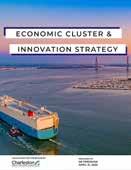
These two regional strategies offer collaborative solutions to strengthen regional resilience and promote sustainable economic growth that benefits all residents. They have informed the CEDS resiliency strategy which is interwoven into this section, the SWOT analysis, goals, objectives, action plans and performance measures. Each can be reviewed for deeper analysis and understanding of regional economic development planning and resiliency efforts.
According to the EDA, economic resiliency, in the context of economic development, maintains three primary attributes: the ability to recover quickly from a shock, the ability to withstand a shock and the ability to avoid the shock altogether. These shocks can be delivered to a region in a variety of ways. They include:
• National or international downturns or significant events, which effect demand of locally produced goods and consumer spending
• Downturns specific to industries that make up a significant portion of the regional economy
• External shocks, such as natural disasters, closure of a military base, departure of a major employer, impacts of climate change, pandemics, etc.
In order to prepare for the inevitable economic challenges, the EDA suggests the placement of economic resilience initiatives, called steady-state initiatives and responsive initiatives. Steady-state initiatives essentially are pro-active strategies, which seek to provide long-term stability, so abrupt shocks don’t upend the status quo. Responsive initiatives are exactly like they sound. These strategies are proactive in a sense, but are aimed at building capacity to respond to shocks out of the region’s reach.
Within the demographic data (pages 6-10) challenges in economic prosperity are apparent. Here we go into further detail on those challenges, current initiatives to find solutions and the risks of not acting. This information informed the SWOT analysis, goals, objectives and action plans that follow this section. As we recommended on the previous page, the One Region Roadmap: Economic Recovery and Resiliency Plan and CRDA’s Economic Cluster and Innovation Strategy should be also be reviewed for further information, planning and context.
An unwelcomed sign of economic prosperity is the congestion that can be found throughout the region. With residential development occurring farther from the city center, drivers spend more time commuting than ever. According to the U.S. Census Bureau, 49% of workers, 16 and older, who do not work from home spend 25 minutes
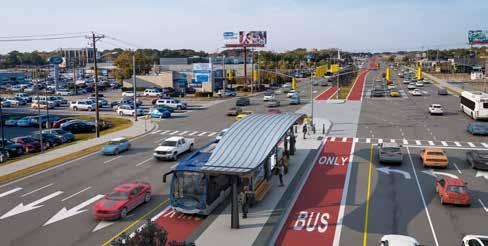
or more commuting in the region. And, 29% of those workers commute to a different county than they live in.1
The BCDCOG looked to address many of these issues in the 2040 Long Range Transportation Plan (LRTP). This multifaceted approach to improving congestion and increasing transportation options is ongoing. Included is the Lowcountry Rapid Transit System (LCRT), the most significant public transportation investment in S.C. In addition, to the 21.3-mile bus rapid transit system the plan also includes a shared use path running the majority of the length of the route, miles of new sidewalks and crosswalks to improve pedestrian safety throughout the corridor. The project entered its engineering phase in the fall of 2022. Construction is estimated to begin in 2026 and take two years to complete.2
Another program is Lowcountry Go, a regional partnership of the BCDCOG, the South Carolina Department of Transportation (SCDOT), the Federal Highway Administration and employers and stakeholders in the tri-county region. Working together, the program focuses on reducing traffic congestion and improving quality of life for our region. Lowcountry Go supports carpools, vanpools, public transit, walking, biking, emergency ride home, and many other programs that encourage behavior
1 – Source: U.S. Census Bureau. 2021. “American Community Survey, 1-Year Estimates.” data.census.gov
2 – Source: Lowcountry Rapid Transit. 2022. “South Carolina’s first mass transit system.” www. lowcountryrapidtransit.com
changes among commuters. In addition, Lowcountry Go works with regional employers to promote sustainable commute options in the workplace, such as work flextime, staggered shifts, and incentives.3
In 2021, the SCDOT adopted a “Complete Streets” policy requiring SCDOT to work with the state’s regional transportation planning partners and regional transit providers to identify and include walking, bicycling and transit needs as part of their regional visioning plans.4
Freight mobility is another important aspect of the area’s transportation system performance and a major driving force for the region’s economy. The BCD Regional Freight Mobility Plan is a blueprint for developing a transportation network that provides for the safe and efficient movement of goods and people, and supports economic growth while simultaneously minimizing the negative impacts associated with increased freight movement. The plan takes an integrated land use-transportation planning approach to identify the area’s freight transportation needs, and provides a comprehensive, multimodal mix of infrastructure improvements, and policy and program recommendations to address these issues.5
These comprehensive approaches to transportation can help alleviate congestion while improving quality of life and retain economic stability for all residents.
With sea levels forecasted to rise and intensity and frequency of storms increasing due to climate change, coastal areas, like the BCD Region, must do all they can to mitigate the effects of flooding. This will require solutions of all sizes. None are bigger than what the U.S. Army Corps of Engineers (USACE) recommended in their Charleston Peninsula Coastal Storm Risk Management Study. Their primary recommendation was for an 8.7-mile,
3 – Source: Lowcountry Go. 2022. www.lowcountrygo.com
4 – Source: SCDOT. Feb 4, 2022. “SCDOT Adopts New ‘Complete Streets’ Policy.” info2.scdot.org/ SCDOTPress/Lists/Posts/Post.aspx?ID=3102
5 – Source: BCDCOG. 2022. “BCD Regional Freight Mobility Plan.” www.bcdcog.com/transportation/ planning/regional-freight-plan
6 – Source: USACE. 2022. “Charleston Peninsula Coastal Storm Risk Management Study.” www.sac. usace.army.mil/Portals/43/docs/civilworks/peninsulastudy/ChsPenStudy_Signed_Chief’s_Report. pdf?ver=Ok2ZD-pG8UPlvzH_mg5tMA%3d%3d
7 – Source: Coastal Conversation League. 2022. www.coastalconservationleague.org/projects/ charleston-peninsula-coastal-flood-risk-management-study-by-the-us-army-corps-of-engineers
8 – City of Charleston. 2022. “Charleston Rainproof.” www.charleston-sc.gov/2312/CharlestonRainproof
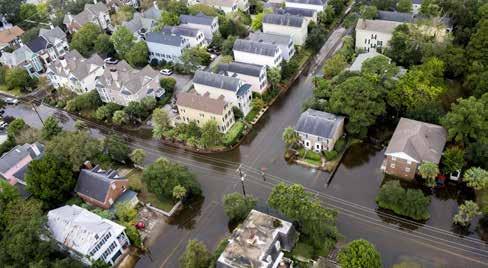
12-foot storm surge wall be constructed along the perimeter of the peninsula. The cost of the recommendations which include five temporary and five permanent hydraulic pump stations, and floodproofing or elevating 100 structures is estimated to be $1.132B, with an estimated annual cost benefit of $448M.6
The Coastal Conversation League has raised concerns that the USAEC project would forever change the sense of place of the peninsula and only be focused on storm surge and not other forms of flooding like tidal flooding and groundwater inundation. They have worked with Sherwood Design Engineers to offer an alternative plan to utilize natural and nature-based solutions in a report titled, Beyond the Wall. 7
Based on public comment the USACE has now agreed to prepare an Environmental Impact Study which will soon be available for public comment and review. Aligning efforts to address flooding across, local, state, federal, businesses and citizens will be key to ensure common ground is reached as solutions are found and implemented.
In addition to massive infrastructure projects, other collective initiatives like the City of Charleston’s Charleston Rainproof, aim to utilize both public and private spaces to capture rain water by installing rain gardens, rain barrels and planting trees and native plants.8
Without urgent, sustainable solutions, businesses and homes will continue to flood, commerce will continue to be disrupted and investment in the area will slow due to increasing risks and costs.
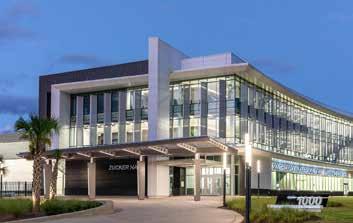
The S.C. Aeronautical Training Center (SCATC) is an example of aligning curriculum with the needs of industry. The SCATC partnerships include Boeing South Carolina, Joint Base Charleston, Clemson University, College of Charleston, The InterTech Group and more. (Photo/Trident Technical College)
Unemployment numbers have rebounded since the initial spread of COVID-19. However, there remains a shortage of workers across many industries. For example, the tourism sector was hit particularly hard as many employees did not come back as the virus waned and the industry roared back. This has forced some restaurants to close and many to cut their hours to accommodate a smaller staff.
According to the 2022 Talent Demand Study conducted by the Charleston Metro Chamber of Commerce and Charleston Regional Development Alliance, the region is expected to add 35,700 new jobs from 2021-2026. Many of the jobs expected to be created require advanced degrees. Recruiting and retaining talent to fill these jobs has become more challenging due to the rising housing costs in the area.
Ensuring the region has the available talent to continue to fuel economic growth will be critical and take collaboration across the region. Curriculum must be aligned with industry needs, more resident’s must be made aware of the region’s opportunities and have the ability to acquire the necessary education and training and salaries must catch up to U.S. averages.
Throughout the Regional Overview section, data showed that economic growth and prosperity are not shared evenly. For example, page 7 shows a person without a high school diploma is four times more likely to live in poverty than someone who has 9 – Source: One Region Roadmap. 2022. www.oneregionstrategy.com
their bachelor’s degree. This highlights how educational attainment strongly influences employment opportunities and income potential.
During the COVID-19 pandemic, the region’s resilience was tested, and households with fewer resources experienced the greatest challenges, particularly those affected by limited broadband access, employment in service industries, and high housing costs.9
The region must work together to expand access to education and workforce training, support small business ownership, increase homeownership, and raise household income levels. A region that broadens opportunity for all residents will be better prepared to withstand future disruptions.
Rapidly rising housing costs combined with lagging salaries has lead to the region becoming less affordable. Without a regional strategy this challenge will only worsen. Lack of attainable housing makes it difficult for someone to buy their first home, one of the primary ways to build wealth through home value appreciation. Instead of benefiting from the rise in housing prices as a homeowner, they only get pushed farther out of the market, and endure rapidly rising rents across the area.
Data on page 9 showed that 52.5% of renter-occupied homes pay 30% or more of their household income on rent. Comparatively, only 26.1% of owner-occupied homes pay 30% or more their household income on homeownership costs. This means a renter is twice as likely to be cost burdened by their home and less able to achieve homeownership.
The ability of the region to attract well-educated people from other region’s is an incredible asset. However, in many cases, these new residents come from larger, more expensive metros, and view the housing prices of the region as inexpensive. With the rise of remote work they are also able to retain their higher salaries when they move. The average salary in the U.S. is about $10,000 more than the average salary of the region (see page 8). These external pressures make the region even less affordable for local residents working for local employers.
The affordability challenge will take a collaborative, regional approach to address. Incentives should be in place for developers to include affordable housing in their plans, communities should preserve affordable housing that is already in place and organizations should work to create homeownership opportunities for residents in neighborhoods where rising property values may cause gentrification.

BCDCOG worked with the CEDS Steering Committee, representing economic development staff from all three counties and the major municipalities in the region. A considerable amount of overlap existed between all of the stakeholder’s positions, thus giving credence to the region-specific aspects of the SWOT analysis.
• Diversity of economic base throughout region
• SC Ports and expanding logistics sector
• Business climate
• Manufacturing base
• Regional collaboration
• International Airport with increased nonstop service
• Commitment by each county to preserving natural and cultural assets that create a unique sense of place
• Quality of life, arts, recreation, food scene, events
• Vibrant urban core and smaller cities and towns
• Joint Base Charleston
• Align regional economic development strategy with regional land use planning
• Increase entrepreneurship support and small business coaching
• Expand higher education and workforce training programs to reach all residents including rural and underserved communities
• Disruption to global manufacturing could bolster demand for local manufacturing
• Development of a Regional Innovation District
• Invest in research and development, workforce development and infrastructure for e-mobility
• Renewable energy
• Small-scale manufacturing
• Increase global fluency
• Opportunity Zones development
• Revitalize existing main street/commercial corridor’s
• Access to affordable, quality early care and childhood education for all residents
• Stress on the Region’s infrastructure from high-growth, including traffic congestion and strain on natural environment
• Public transportation, walking and biking opportunities
• Broadband access
• Access to capital and business coaching for entrepreneurs
• Limited affordable office, commercial and smaller manufacturing spaces
• Housing choices and affordability

• Labor force leaving, or not willing to relocate to area, because of affordability (Housing, Transportation, Cost of living)
• Increasing flooding and storm intensity from rising sea levels and a changing climate
• Potential economic and natural disruptions such as recessions, global conflict, pandemics, hurricanes or earthquakes
• Displacement and gentrification driven by economic prosperity
• Loss of natural and cultural assets due to development
• Loss of sense of place
• Economic opportunity gaps
• Salaries lagging the U.S.
The Strategic Direction and Action Plan presents a framework for the questions of what, as a region, do we want to see happen in the future? How will we accomplish what that vision will eventually look like?

“The BCD Region will aspire to flourish regionally by pursuing sustainable economic prosperity through wise, diverse investment, devotion to maintaining a high quality of life for all residents and for preserving the natural and cultural assets of the tri-county area.”
Should all three tiers (wise diverse investment, high quality of life for all residents and preserving the natural and cultural assets of the region) of the BCD Regional Vision be strived for and accomplished, the region will not only profit from an economic standpoint, but from an expansive social capital perspective as well. This would perpetuate a virtuous cycle where economic investment and quality of life are made of equal importance.
The following goals and objectives will serve as an overarching framework for the CEDS and outline how to accomplish the region’s vision. Below each objective are actionable items, examples of current initiatives to build on and ideas for the success and betterment of the region. These were informed by the CEDS Steering Committee, One Region Roadmap: Economic Recovery and Resiliency Plan, the CRDA’s Economic Cluster & Innovation Strategy, Joint Regional Business Service Strategies of the South Coast Regional Plan and ongoing economic development strategies within Berkeley, Charleston and Dorchester Counties.
Goal 1: Grow and support the region’s economic base to provide long-term economic resiliency.
Objective 1.1: Work to maintain the existing diversity of sectors present in the region
• Offer a high-level of service to existing companies to ensure that they are supported and appreciated, and reinforce that they are doing business in the right location. Example: The Business Concierge Program run by Charleston County Economic Development
• Continue to support Joint Base Charleston and the private-sector defense industry.
• Recruit related industries to major sectors in the region. Example: Recruiting an aircraft parts manufacturer to complement existing aerospace sector
Objective 1.2: Highlight the region as a global center for commerce
• Promote the continued success and expansion of SC Ports, and the logistics sector, to position the region as the premier gateway to reach the global market place.
• Recruit international businesses by marketing the region to a targeted global audience and attending international conventions and conferences related to the region’s major sectors such as the Farnborough International Airshow.
• Improve global fluency to make the region more welcoming to international businesses, workers and students. Example: The 2022 Global Connectivity Snapshot produced the CRDA.
Objective 1.3: Support the Joint Regional Business Service Strategies of the South Coast Regional Plan, as adopted by the Trident Workforce Development Board (TWDB)
• Ensure partnership and collaboration among partner agencies assists individuals and businesses with achieving their workforce goals.
• Facilitate rapid re-employment for workers who have lost their jobs.
• Increase access to resources and services for workforce development through technology and outreach. Example: SC Works has deployed the SC Career Coach a mobile workforce training unit serving rural communities with limited access to the internet
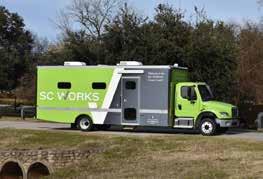
Objective 1.4: Continue region-wide infrastructure improvement projects to sustain the growth brought by new economic investments
• Coordinate capital improvement planning across regional, county and local governments to align regional infrastructure investments.
• Encourage economic development to occur in areas where infrastructure exists and can be improved without disruption to the environment and community.
Goal 2: Create a region where all residents have access to high-quality education, jobs and housing.
Objective 2.1: Strengthen educational outcomes and expand access to postsecondary, industry-focused training, and apprenticeship program
• Support organizations that take a collaborative approach to improving educational performance, workforce readiness, and career-aligned learning opportunities.
• Foster stronger partnerships among schools, technical colleges, and employers to align curricula with current and emerging industry needs, and develop clear career pathways connecting education and training to high-demand jobs.
Objective 2.2: Increase household income levels by expanding access to career pathways and skills-based training.
• Promote high-demand occupations in the region and opportunities to gain the skills needed to obtain those jobs.
• Encourage businesses to invest in workforce training, career advancement, and supportive workplace cultures that retain and develop talent.
• Engage with workforce development initiatives such as SC Works Trident, whose programs range from WIOA work programs to Vocational Rehabilitation.
• Educate residents on the value of upskilling and lifelong learning.
Example: The Charleston Metro Chamber’s reports, Common Skills in High Demand and Mapping Your Path.
Objective 2.3: Strengthen and expand small business development across the region
• Create and capitalize investment funds that provide flexible financing for small business growth and innovation.
• Support programs that accelerate entrepreneurship, business development, and local ownership.
• Expand awareness and use of regional business directories and networks to connect local firms with customers, partners, and resources.
Objective 2.4: Expand digital skills and access to affordable technology so all residents can fully participate in the modern economy
• Support programs that provide digital-skills training, device access, and assistance with affordable internet options.
• Promote digital navigation resources that help residents and small businesses use online tools for education, employment, and entrepreneurship.
Objective 2.5: Promote benefits of development within Opportunity Zones to attract investment and create jobs in economically distressed areas
• Inform potential investors and developers of availability and benefits of investing in designated Opportunity Zones. Example: Dorchester County Economic Development Opportunity Zones website: www.dorchesterscopportunityzones.com
• Engage with nearby communities to ensure they are informed about proposed developments and understand the potential economic benefits.

Goal 3: Provide a supportive environment for business, innovation and entrepreneurship to thrive and attract businesses to the region.
Objective 3.1: Ensure that grants and incentives continue to be offered for the security of attracting more businesses to the region
• Continue state incentives as laid out by the South Carolina Department of Commerce.
• Educate potential relocating, or expanding businesses, about the grants available from the S.C. Coordinating Council for Economic Development for upgrading or extending roads, water and sewer or to underwrite site development costs.
Objective 3.2: Recruit and grow new, innovative sectors that strengthen the region’s long-term economic resilience
• Develop an Innovation District with cutting edge spaces for life sciences and information technology.
• Recruit businesses that diversify and complement the region's core industry sectors.
• Support emerging sectors such as maritime and shipbuilding, e-mobility, renewable energy and small-scale manufacturing the region can be competitive in, and create the environment for successful investment and recruitment. See page 19 for more information.
Objective 3.3: Support innovation and entrepreneurship across the region
• Connect entrepreneurs with venture capital and other available sources of funding to fuel growth.
• Support incubators and accelerators to fuel business growth and employment opportunities. Examples: The Harbor Entrepreneur Center, Charleston Digital Corridor
• Provide first-time entrepreneurs with essential business launch services.
Objective 3.4: Increase the number of regional businesses utilizing SC Ports to reach the global marketplace
• Encourage regional businesses to work with the U.S. International Trade Administration’s Charleston Office and utilize the export services provided by S.C. Department of Commerce to learn more about importing/exporting.
Goal 4: Ensure the region has the available talent to drive economic growth through diverse education and training opportunities and effective recruitment and retention strategies.
Objective 4.1: Continue to invest in education and training programs to provide residents across all skill levels with access to opportunity
• Collaborate with the CRDA, Chamber and county economic development directors to support programs such as readySC. ManuFirstSCTM, Career Academies and Youth Apprenticeships for middle schools and high schools in the region.
• Support programs like Early College High School, located at the Palmer Campus of Trident Tech in partnership with Charleston County School District, where students can complete up to two years of college credit while earning a high school diploma.
Objective 4.2: Increase awareness of local job opportunities among all residents
• Expose youth and young adults to in-demand skills and professions.
• Educate adults on opportunities to advance their careers and the ways to obtain the necessary skills.
Objective 4.3: Enhance educational curriculum to align with needs of employers
• Support efforts such as, SC Works sector partnerships, partnering business leaders in the same industry and labor market with partners in education, workforce development and economic development to create a pipeline of skilled workers to address current and future needs.
• Conduct annual summit between major employers and colleges, universities and workforce development organizations to align curriculum with industry needs.
Objective 4.4: Enhance global visibility of regional education and employment opportunities
• Promote regional incubators, accelerators, venture capital funding sources, incentives and other regional business support services to a global audience.
• Support programs like Study South Carolina, a not-for-profit consortia of accredited public and private universities, colleges, and secondary schools focused on connecting international students with opportunities and resources for studying abroad in South Carolina.
Goal 5: Increase communication, cooperation and coordination between governments, organizations, businesses and citizens to strengthen regional unity.
Objective 5.1: Continue to build upon existing channels of communication and events that foster intergovernmental cooperation
• Work with regional organizations such as BCDCOG, Charleston Metro Chamber of Commerce, Coastal Community Foundation, CRDA and Tri-County Cradle to Career to identify regional challenges and develop solutions.
• Encourage leaders to participate in regional events that foster collaboration, shared understanding, and dialogue on issues affecting the region’s long-term economic prosperity and community well-being.
Objective 5.2: Align community with the objectives of the One Region Roadmap: Economic Recovery & Resilience Plan
• Support local organizations that are leading each of the eight regional dynamics identified in the One Region Roadmap: Economic Recovery & Resilience Plan to increase participation, awareness and opportunities for success.
• Create a One Region Roadmap toolkit for government and elected officials, businesses, organizations and individuals to promote and participate in the implementation of the strategy.
Objective 5.3: Show the connection between economic growth and the benefits to the community
• Educate the community on the benefits of economic development in terms of higher wages and a larger tax base and how they can take part in, and benefit from, economic growth.
• Facilitate partnerships between industry leaders and community organizations to increase corporate engagement and investment in local communities.
• Coordinate community outreach efforts when development is being considered so residents are part of the process.
• Maintain community engagement after development projects are complete to ensure stated goals and objectives are met.


Goal 6: Ensure growth in the region reinforces a strong sense of place, preserves cultural and natural resources, includes ample attainable housing and offers a wide range of transportation choices.
Objective 6.1: Align regional and local economic development strategies with regional land use planning to locate industries where cultural and natural resources are least impacted
• Identify areas where development should not occur in order to preserve important habitats or artifacts.
• Create a land preservation and acquisition program to retain open space and natural habitats that support resiliency.
• Develop a regional watershed approach to open space preservation and the use of natural systems in flood and drainage management.
• Environmental mitigation efforts due to development should occur close to affected areas or within the region when possible.
• Create and implement parks and recreation plans at the local and regional levels.
• Support the cleaning and redevelopment of brownfields and encourage participation in the EPA’s Brownfields and Land Revitalization Program to assist in funding.
Objective 6.2: Build regional collaboration and unity around the urgent need for attainable housing.
• Pursue opportunities to expand funding for the renovation and preservation of naturally occurring affordable housing.
• Champion inclusion of 20% affordable housing within a quarter mile of a premium transit station.
• Create a regional Affordable Housing Dashboard based on the one established by the City of Charleston.
• Support efforts of organizations like Community First Land Trust that aim to prevent gentrification, preserve housing affordability and give the homeowners the opportunity to build wealth.
• Simplify incentives for developers to include affordable housing within their plans.
Objective 6.3: Elevate the urgency to invest in infrastructure improvements that increase resiliency and competitiveness
• Invest in multimodal transportation, such as the Lowcountry Rapid Transit System, to decrease the dependency on cars and increase access to the region for all residents.
• Improve broadband connectivity, especially in rural and distressed areas.
• Invest in plans and solutions to combat flooding and engage government, business and residents for alignment.
• Continue to implement the Walk Bike BCD Masterplan that envisions connecting communities through investing in safe walking and biking infrastructure.
• Invest in e-mobility including: training the workforce, building the charging infrastructure and electrifying the logistics industry.
The following indicators will be used to track progress in each of the six goals stated in the CEDS.
Indicators to track
• Number of Jobs in Priority Clusters
• Number of Businesses in Priority Clusters
• Gross Regional Product
• Number of International Companies with over 50 Employees
• Volume at SC Ports
• Annual Regional Payroll
Indicators to track
• Degree attainment by County
• Difference in Median Household Income by County
• Difference in Unemployment Rate by County
• Number of Small Businesses
• Percentage of Households with Access to High-Speed Internet
Indicators to track
• Number of Patents Filed Annually
• Percentage of Knowledge-based Workers
• Concentration of Small to Mid-Size Businesses
• Patents Issued
• NIH/NSF/NEA Funding
• Venture Capital Funding
Indicators to track
• Labor Force Participation Rate
• Share of Region Workers with a Bachelor’s Degree
• Science-Related Graduate Students
• Annual College and University Graduates Produced by the Region
• Number of Foreign-Born Residents
Indicators to track
• Identify the number of regional and multi-jurisdictional initiatives that address issues of mutual concern and related outreach efforts
Indicators to track
• Percentage of People with Commutes Less than 30 Minutes
• Percentage of Population who Walked or Biked to Work
• Percentage of Population Utilizing Public Transportation
• Number of Affordable Rental Units
• Percentage of Renter-occupied Households that are Housing Cost Burdened
• Monthly Eviction Filings
• Percentage of Population Currently Living in an Area with a Medium Walkability Score or Greater
• Acres of Preserved Open Space
